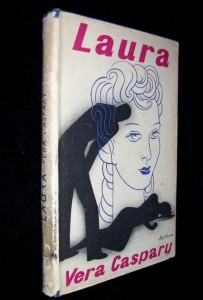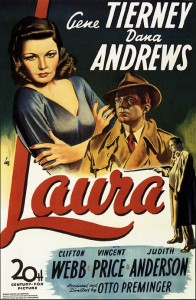 Laura—Vera Caspary–1943 (it ran as a serial in a magazine in 1942 before being published as a novel)–used paperback
Laura—Vera Caspary–1943 (it ran as a serial in a magazine in 1942 before being published as a novel)–used paperback
I recently read another Vera Caspary title, Bedelia, and the only similarity to Laura is the author. Bedelia is a nice character study of a beguiling black widow, whose latest husband finally catches on. It holds neither the suspense or surprise that Laura does. Since a great deal of the impact of the novel, Laura, is intertwined with the plot–I’ll need to give a general *Spoiler Alert” for the entire article! That’s assuming you are one of the few people who never heard of or saw the classic film starring Gene Tierney and Dana Andrews, nor saw the billion rip-offs on episodic television.
I chose Laura for my best list for several reasons, but the greatest being it’s huge turnaround within the middle of the book. When the reader first encounters the characters, the point of view is of Waldo Lydecker, Laura’s very good friend and ex-lover. The second section of the book is seen through the eyes of the detective in charge of the murder investigation, Mark McPherson; and the third by, Laura herself. Waldo Lydecker is a fat self-satisfied writer and is devoted to Laura. Laura’s finance, on the other hand is a philandering weakling, Shelby Carpenter. Laura’s aunt, Susan Treadwell, is another unpleasant individual hovering around Laura’s world. And Laura herself–a strong, beautiful career woman, successful as an advertising executive, whose generosity brings her murder.
Laura is the victim. Shot point blank in the face with a shotgun as she answered her doorbell wearing a neglige. As the investigation into her death is spun, McPherson slowly becomes fascinated with the memory of Laura, through the statements by her friends, the objects in her home, and in particular, the portrait of her, hanging on the wall. By the time the great surprise occurs, McPherson is totally in love with the dead Laura, as is the reader. We wish we had known her in life, been able to save her, the way McPherson feels.
So when Laura turns up not dead after all, but instead, a young model Laura took pity on and let stay in her home while she was away for a few days, turns out to be the corpse, we as readers, besides being thoroughly thrown, are relieved to learn the character we came to love is back and not just in a dreamlike memory.

Having this switch of identity is done to distraction on TV and literature these days–over and over again mistaken identity is used as a plot twist–except the twist tends to come unbound considering as readers and viewers we’ve guessed the big secret within minutes. I remember distinctly watching a first run episode of Magnum, P.I. where a famous actress is found dead, face blown to pieces, with Magnum investigating. I yelled at the screen–“Laura, you dopes!” As if the writers could hear me and retroactively rewrite the script so the story wasn’t so obvious. And in the years following I bet I saw half a dozen things that thought they were being clever when in fact I could yell “Laura” and be right on the money. But when first introduced via book, it must have been a real thrill to know that the wool had been pulled over your readers eyes. Because of the way that Caspary related the crime and the suspects, you never once question that it was Laura who was killed. The story is so completely engrossing in the complexity in finding this beautiful woman’s murderer, that it’s almost inconceivable it could be any one but Laura, her memory and spirit seems to linger in the air of her home and like a ghost beside the characters as they talk about her. When the corpse turns out to be that of Diane Redfern, everything changes. No longer is Laura a memory, but flesh and blood, and now the number one suspect.
If one has seen the film, and not read the book, you are doing a disservice to Vera Caspary. There are a number of large differences between book and film–mostly character driven. Caspary and the director of the film, Otto Preminger fought over how he presented Laura on film. He is reported to have said that the character of Laura was a non-entity, a nothing. Which is the farthest from the truth in the book as one can get. Laura is the center of the story, the soul that drives the tale, and her strong feminist being was chopped down to an almost statue-like performance by Gene Tierney, under Preminger’s direction, a fact Caspary never forgave or forgot. Watching the film you get the sense that Laura was a vessel filled by men, that her own will is weak, men tend to utilize her, it was men that helped her gain prominence in the advertising profession. This presentation robs the story of the real character of Laura, and makes her almost secondary to the overall plot.
And then there’s the characterization of Laura’s friend, Lydecker. He’s a nasty fat fellow in the book. On film he’s effeminate and prissy–completely different from Caspary’s vision. This change also alters the story in a damaging way. If we are to believe that this man loved Laura to the point of murder, why would he seem as effete as his character is written in the film?
 Despite these differences, the film is still a wonderful piece, and I loved watching it–but for me it’s the kind of thing that once the secret is out, there is no longer suspense to look forward to. Odd, because I have no problem watching The Maltese Falcon, or The Big Sleep to infinity. It’s not that hard to imagine audiences reaction to the surprise–it probably had the same response as the end of The Sixth Sense did–whaaaaaaat?
Despite these differences, the film is still a wonderful piece, and I loved watching it–but for me it’s the kind of thing that once the secret is out, there is no longer suspense to look forward to. Odd, because I have no problem watching The Maltese Falcon, or The Big Sleep to infinity. It’s not that hard to imagine audiences reaction to the surprise–it probably had the same response as the end of The Sixth Sense did–whaaaaaaat?
There is a much better review and article than mine, lol, about the book, the differences between film and novel here.
Hopefully, no one ignored my spoiler alert who hasn’t read the book, because this is one twist that truly ruins the entire experience if revealed!
Don’t forget to check out the list of Best 100 Mysteries Of All Time
